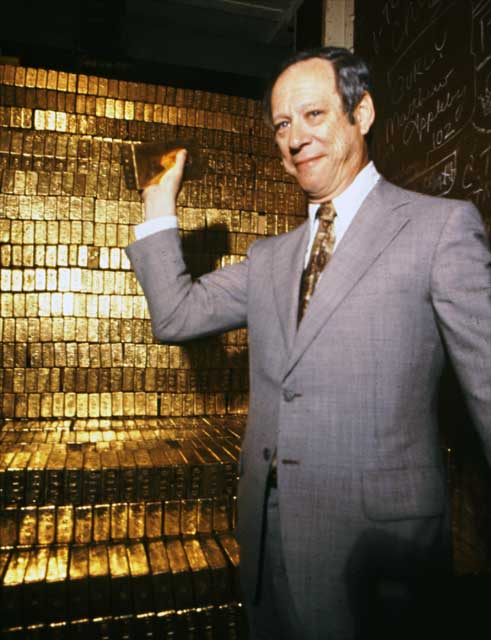From the Vault of Art Shay: Fortune-ate Optimism
By Art Shay in News on Jun 29, 2011 4:00PM
The July 4 issue of Fortune is not amongst its thickest: I think I still have the magnificent one-inch thick issue on Japan that initially help seduce me into photography. On the cover Fortune uses the candid portrait of a handsome black man being groomed by two white barbers and an Asia lady either running her computer mouse over his smiling cheek, or listening to its mechanism with his left ear.
Doesn't matter. This guy exudes so much winning spirit, the caption might as well have been ripped from his diary: Getting ahead in a volatile economy means making yourself over with new social media and other skills. Don't fear change: embrace it. This man for our season could only make himself over downward - that is, to be head of some Lehman Brother offshoot or medical team that just cured cancer, made great strides on leprosy, and was incidentally elected mayor of New York during the intermission of his play.
Having had some 900 pictures in Fortune since 1951, I am their fan for life. Them wonderful Time Inc. checks - Ray Kroc eating that first McDonald's whopper at his McDonald's University commencement speech in Des Plaines; that Israeli boat dropping coils of steel off at Indiana Harbor cheaper than Japan or China can do it. Or my essay and cover on John Deere where my 35mm Kodachrome slide of how they set the cutting edge of their tractor beat out the frames made by 17 - count 'em - John Deere photographers determined to out-Fortune Fortune's "man from Chicago" to their collateral embarrassment. Keeping in mind the two other promos on the cover are: "100 great things about America" and "How Android is winning the smartphone smackdown."
So it's great to report on one of my old alma maters cheerleading the oncoming express train of America on track again.
Despite my wife's being on the point of selling her Motorola stock after watching it tank over the years: here is a nice smiling snapshot of Sanjay Jha talking up Motorola's plans for revivification. (Maybe she'll sell the shares to me?)
Big smiling picture of oil lobbyist Jack Gerard trying to make the oil companies seem kinder and gentler and less profitable than they really are.
Mystery writer Paul Levine looks younger than his 63 winters, but he published 13 of his own works and sold 400,000 copies of a single one of them. That's equal to dribbling through the entire Dallas Mavericks team to score a basket. Now he buys rights to out-of-print books and promos the hell out of them. How happy some dead authors must be!
Mae Tai O'Malley is shown in a momentary pause at leading squadrons of lady lawyers into health insurance frays at a modest $200 an hour, "fixing a broken industry."
"Once block-busted, now yogurt king" is the headline introducing David Kahn. Telling how he blew a bunch of Blockbuster and Subway franchises. But he bootstrapped himself back into the bucks with a group of Yogurtland stands. No time to say how, he sold 40% of his new gig for $3 million.
Chubby Mike Merrrill was laid off then somehow began to do presentations on marketing. You know - use Facebook and Twitter to make dough, not friends. Like that.
My own favorite optimistic story I worked on Fortune? Trying to convince Henry Crown to let me photograph him for the magazine. I finally learned that he'd be at the 1956 opening of the Dallas Hilton watching Connie Hilton dance the Varsuvienne with this pretty Hollywood bimbo. He was a shy man with absolutely nothing to be shy about, so I promised Crown I'd not use a flash nor make a "Life Magazine production" out of him and I was able to wire Fortune that as the song's lyrics went: "Someday your Crown prints will come."
Crown was all optimism tethered to a super-brain. It was he around this time who convinced the original Mayor Daley that a California digger named Grafe-Callahan could do well for all concerned by digging a tunnel under the lake and processing the pristine rocks from the lake to underpave many Chicago roadways and home sites. And, oh yes, the best way to do this would be to build a temporary rock-grinding plant on the lake shore at Addison. His will was done on earth as if it came from Heaven.
Then, thinking that Colonel Crown observed Christmas, Grafe-Callahan hired me to do a book for Crown on their operation. "A great Channukah gift," the Colonel told Grafe-Calahan. Especially since it used my Fortune picture of five or six of his grandkids drinking the pure Chicago water filtered by and transported over the clean rocks the Colonel had wrested and processed from the lake.
PS: After I finished writing the above paean to Fortune and optimism, I had a chore to do: make a list of all the anti-cancer drugs my wife has received during her so far three-month battle.
Suddenly the new New Yorker fell to hand. In it was a touching "Personal History" article by Aleksandar Hemon.
Hemon is the amazing Bosnian writer who now calls Chicago home and, in a decade or so, has become just about our best international writer. A Nabokovian language feat.
He brought me to tears as he writes about the brain cancer suffered by his year-old daughter Isabel. Not just writes about it, but places Isabel, her three-year-old sister Ella, and his beautiful wife Teri, firmly in our hearts. Hemon also notes the professional attentions Children's Hospital dispenses, except when they proffer unwanted religious counsel. How do I know Teri is beautiful? I worked with her on a Chicago article for Granta magazine and on one of the last nights of 2009 at the Rainbow Club on Damen, just around the corner from Division, Teri - who was swellingly pregnant with Isabel at the time - introduced me to her husband. Aleksandar, a physical as well as a literary giant, had recently won a MacArthur and under Teri's and Granta's auspicies I gave a slide show on Algren's and my old haunts before 300 Bucktown fans. The Hemons were interested in buying one of my Algren pictures for their apartment.
The next day I came down with such pain I needed colon surgery .
My lifetime optimism, something like Fortune's above, continued into my medical battle and now my cheery wife's. Only the heartfelt artistry of Hemon's own pain has shaken my faith in life's ability to shrug itself dry and once again dive into its deeps, steeps and creeps - to use a phrase I prevented Algren from using as his first-choice title for "A Walk on the Wild Side".
Rather than give you a precis of Hemon's writing, not just in the current New Yorker, but, say in his classics, Nowhere Man and The Lazarus Project, let me quote the prescient Donna Seaman:
"Aleksandar Hemon, who possesses a diabolical sense of humor and a wickedly visceral sensibility...considers the precariousness of existence, the continual revision of identity and dreams that immigrant life demands, and the ever-present shadow of death."
And there we have Studs again, still alive as I keep hocking you: "It's all connected, ain't it."
So it was Fortune that led the first cheerleading on Colonel Crown's optimism- a thinking-out-of-the-box optimism kind of rare these days, but on current view in the July 4th house organ of my alma mater.






